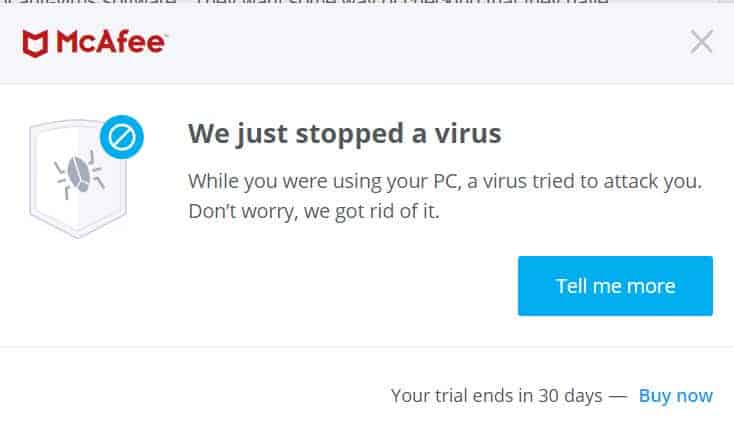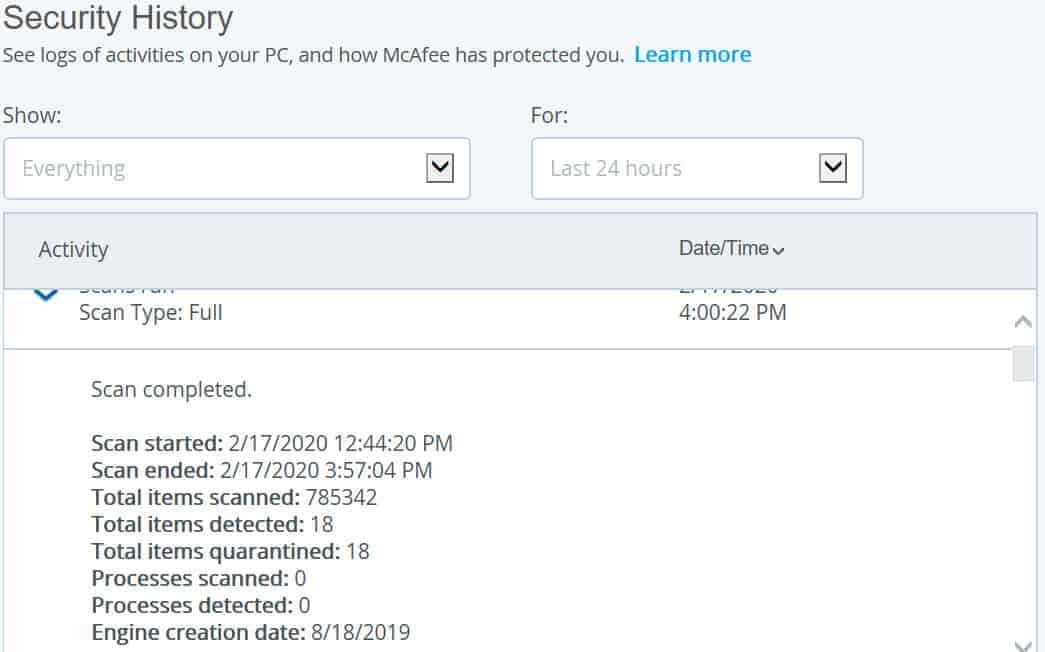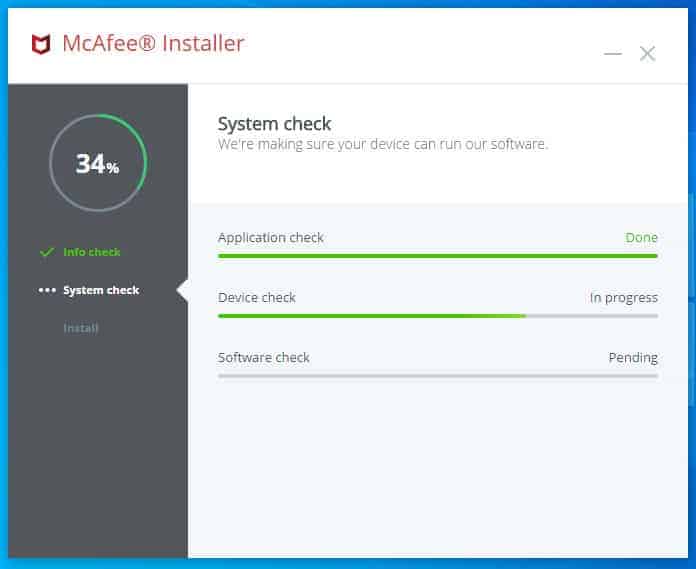Heard of McAfee or Avast? Odds are, you have – even if you’ve never hit the “buy” button. These antivirus giants are no strangers in the cybersecurity world, trusted by millions to put a security lock on their devices. But when the rubber meets the road, which one is your best bet for top-notch security, extra features, and a price tag that won’t break the bank? That’s what I aim to uncover.
For this showdown, I’m not just relying on marketing buzz. I’ll be throwing both antivirus solutions into the ring, subjecting them to our tests, as well as sifting through the latest findings from independent antivirus labs. Get ready for a deep dive into malware protection, cost-effectiveness, extra bells and whistles, and user experience.
Here’s my two cents: McAfee gets my vote. It aced our recent tests, offers good value, and brings added perks like a file shredder and ID protection to the table.
If you don’t have enough time to read the full comparison, here is the quick version. McAfee is my preferred choice, after recording impressive protection results in my own recent tests. It is also priced at a good value level and includes a number of useful security features like a file shredder and ID protection.
Summary: McAfee vs Avast
McAfee
|
Avast
|
| No value | McAfee | Avast |
| Website | mcafee.com | avast.com | Antivirus and Antispyware | Firewall | Web protection/anti phishing | Parental controls | Password Manager | Webcam protection | PC Cloud Backup | VPN | Ransomware protection | Banking and Payment Protection | Network Attack Protection | Secure data encryption | Automatically update apps | File Shredder | Performance Optimization | Identity Theft Protection |
|---|---|---|
| Best deal (per month) | $3.33 SAVE $80 on a 2 year plan - 5 devices | $2.10 Holiday SALE! Save up to 65% |
Background
McAfee is one of the most well-known antivirus brands around the world and has over 7,000 employees in 189 countries. Current stats released from McAfee claim that they cover 525 million consumer internet-enabled devices such as PCs, tablets, and mobiles. McAfee was founded in 1987 and is headquartered in the United States.
You might also be familiar with the founder, John McAfee, a man who lived an extraordinary, controversial and wholly unbelievable life.
Avast was founded in the Czech Republic and has grown to 1,700 employees worldwide. The company fact sheet shows that Avast currently has 425 million active users and the company’s most popular markets are in the US & Canada, Brazil, France, Russia, and Germany. Some negative news broke about Avast early in 2020. Reports revealed the antivirus product had been collecting user data and selling it on through one of their subsidiaries, Jumpshot.
In 2016, Avast acquired antivirus company AVG. Over the last few years, Avast and AVG have combined the backend of their products, their detection methods, behavior blocking and cloud, to offer the same level of protection with different packages and interfaces. In August 2021, Norton announced that it would be acquiring Avast antivirus. As of the time of writing, Avast and Norton products remain separate. However, in the future, Avast and Norton’s detection capabilities could be combined to create a much more powerful security suite, as they are both market leaders. Norton also acquired antivirus company Avira in July 2020.
Pricing & Compatibility
At the time of writing McAfee has three different options for its main antivirus product, McAfee Total Protection. The only difference between the three options is the number of devices that are protected with each plan: one, five, and 10. Next up the subscription tiers is the same antivirus plus a VPN to cover five devices. Finally, McAfee offers a LifeSafe version that covers unlimited devices.
In contrast, Avast keeps its offers simple with a free basic version and Avast Premium Security for one or 10 devices. It’s also worth mentioning here that Avast has launched Avast Omni in the United States. This is a total solution that protects all IoT devices via your home router and also protects mobile devices wherever you go. There is a free 90-day trial available for users in the US (as long as your home router is compatible with the service) and then you have the option to upgrade after the trial period.
| No value | McAfee Total Protection Basic | McAfee Total Protection Plus | McAfee Total Protection Premium | McAfee Total Protection Advanced |
| Website | mcafee.com | mcafee.com | mcafee.com | mcafee.com | One year price | $29.99 | 39.99 | $49.99 | $89.99 | Renewal price | $84.99 | $109.00 | $129.99 | $179.99 |
|---|---|---|---|---|
| Best deal (per month) | $2.49 $2.49/mo for the annual plan - 1 device | $3.33 SAVE $80 on a 2 year plan - 5 devices | $4.16 SAVE $85 on a 2 year plan - 10 devices | $6.24 Unlimited Devices - $6.24/mo 1yr plan |
| No value | Avast One Free Antivirus | Avast One | Avast Premium Security | Avast One Individual | Avast One Family |
| Website | avast.com | avast.com | avast.com | avast.com | avast.com | One year price | Free | $39.99 | $50.28 | $50.28 | $69.48 | Renewal price | N/A | $69.99 | $75.99 | $99.99 | $139.99 |
|---|---|---|---|---|---|
| Best deal (per month) | Free FREE download | $2.80 GET 66% off 2 year plans | $2.10 GET 66% off 2 year plans | $2.80 GET 66% off 2 year plans | $3.95 GET 66% OFF 2 YEAR PLANS |
As the tables above show, McAfee subscriptions cost more in general for like-for-like subscription tiers.
One note in McAfee’s favor is that it offers a discounted price for the first year of subscription, while Avast does not offer a first-year discount. Avast do offer cheaper pricing if you sign up for longer than a year, with two- and three-year subscriptions available.
Avast offers a 30-day money-back guarantee, so you will need to purchase the product and request a refund if you’re not happy with it. In contrast, McAfee offers a 30-day free trial so you can download Total Protection for free without a credit card.
While it may seem like the free trial from McAfee is less hassle if you want to try before you buy, I can confirm that I have used the Avast money-back guarantee and it is a simple process. I simply informed them I no longer had a need for the antivirus and wanted to cancel within the 30-day period and was sent a full refund back to my payment card within a few days.
McAfee’s Total Protection includes ID monitoring, and that this is not included with Avast. Both McAfee and Avast are compatible with Windows PCs, iOS, Android and macOS.
Effectiveness against malware
To establish which antivirus provides the best protection against malware, I ran my own malware tests on a PC to see how each program performed.
First, I ran a real-time test that detects malware threats as you use the PC instead of only looking for them during a scan.
Next, I ran a second type of test in which I turned off the real-time detection feature in the antivirus program, re-downloaded the malware test files, and ran a scan to see the results on an already infected machine.
I used various sample malware test files from EICAR (the European Institute for Computer Antivirus Research) to test how they both respond against malware in different forms and from both secure and insecure connections.
I also tested the results with both a full scan and a quick scan, the latter being a lighter version of the full feature. The quick scan option does not scan the full system and only checks files in the most common areas targeted by malware.
The results below show how each antivirus performed on my PC against three live samples containing both trojans and adware and four different EICAR samples.
| No value | McAfee | Avast |
| Website | mcafee.com | avast.com | Eicar Sample 1 | Blocked | Allowed | Eicar Sample 2 | Blocked | Allowed | Eicar Sample 3 | Blocked | Allowed | Eicar Sample 4 | Blocked | Allowed | Live Sample 1 (Adware) | Blocked | Blocked | Live Sample 2 (Trojan) | Blocked | Blocked | Live Sample 3 (Trojan) | Blocked | Blocked |
|---|---|---|
| Best deal (per month) | $3.33 SAVE $80 on a 2 year plan - 5 devices | $2.10 Holiday SALE! Save up to 65% |
Avast allowed the EICAR samples when downloaded over HTTPS, but blocked them on HTTP. Avast did, however, detect and delete all live samples.
McAfee blocked all EICAR sample download attempts and blocked attempts to install live malware samples from password-protected files too.
Both McAfee and Avast have a quick scan setting within the interface. Both failed to detect the EICAR and live samples in quick scan mode.
In addition to my own tests, I reviewed the latest product testing results from two respected independent test labs, AV-Test and AV-Comparatives.
The latest Malware Protection Test available from AV-Comparatives was published in September 2019, giving us a recent indication of how each product is performing against malware.
McAfee scored a perfect malware protection rate of 100 percent placing joint first. Avast scored slightly lower, with a perfect score of 99.97 percent protection, still placing it in the top cluster of performers.
During September and October 2021, AV-Test evaluated several major security products for home users. Both McAfee and Avast received a perfect six for protection, performance, and usability.
So, the numbers from independent test labs give McAfee the slight edge over Avast, but show that Avast is still a top performer.
Another test run by both independent labs shows the number of times each software incorrectly identifies a file or app as a threat. The lower the number of false alarms, the better.
The test results from September show McAfee recorded two false positives while Avast had four.
Impact on PC performance
To test the impact of each antivirus on PC speed, I compared my own experience and recorded some numbers while running scans with both products. I also looked at some performance benchmarking tests from independent test labs.
To try out how each security suite performed on my own PC, I recorded the time to complete both a full scan and a quick scan. A full scan looks at every file on your machine, while a quick scan only looks at areas known to be most common for malware infections.
How long each scan takes depends on several factors including the number of files and volume of the data on your PC, the speed of your PC and the antivirus engine itself.
| No value | McAfee | Avast |
| Website | mcafee.com | avast.com | Full Scan Time (minutes) | 223 | 60 | Number of scanned objects | 785000 | 1870000 | Full Scan CPU Utilization % | 100 | 72 | Full Scan Memory Utilization % | 75 | 300 | Full Scan Disk Utilization (seconds) | 253 | 19 | Control CPU Utliization % (no scan) | 12 | 72 | Control Memory Utilization % (no scan) | 10 | 28 | Control Disk Utilization (seconds) (no scan) | 66 | 32 | Quick Scan Time (seconds) | 633 | 64 | Quick Scan CPU Utilization % | 39 | 42 | Quick Scan Memory Utilization % | 77 | 73 | Quick Scan Disk Utilization (seconds) | 912 | 5801 |
|---|---|---|
| Best deal (per month) | $3.33 SAVE $80 on a 2 year plan - 5 devices | $2.10 Holiday SALE! Save up to 65% |
I ran a full scan with Avast first in a time of 60 minutes which scanned 1870000 items. In comparison, McAfee took substantially longer at 223 minutes to scan 785000 items.
Later, I ran a quick scan with both programs. Avast timed just 146 seconds to complete the quick scan while McAfee took almost 4.5x longer to perform the task at 633 seconds.
I also recorded some data to see the numbers on how my PC’s resources were affected by both antivirus programs.
Avast recorded higher Control CPU and Control Memory utilization, but lower Control Disk utilization when idle (not performing a scan) compared to McAfee. During a full scan, Avast scored lower CPU and Memory utilization next to McAfee.
Independent AV labs’ performance tests measure how installing the antivirus impacts PC performance during eight common tasks:
- Downloading files
- Browsing websites
- File copying: first and subsequent run
- Installing/uninstalling applications
- Archiving/unarchiving
- Launching applications: first and subsequent run
Each task is given a rating between very fast and slow.
AV-Comparatives Performance Test from October 2021 show that McAfee and Avast score some of the highest scores, with the top very fast rating given to seven out of eight scenarios, receiving fast ratings in one. For Avast, the first run of an application was rated fast instead of very fast, and for McAafee installing applications was given a fast rating.
AV-Test’s performance results from September and October 2021 give Avast 6.0/6.0 and show that the software outperforms industry averages in a number of categories. McAfee also scores 6.0/6.0, outperforming many industry averages when running on both a standard and high-end PC.
Both tests gave similar results, and show that both affect performance very little. From my personal experience, I found both products fine to use but noticed that there was virtually no drop off in terms of speed for launching applications and loading websites with McAfee in particular.
Features
The antivirus engine is the main product, but all AV brands bundle in extras to enhance PC security. Which provides the best added features, Avast Premium or McAfee Total Protection?
- Award-winning Antivirus
- Performance Optimization
- Home Network Security
- Security Experts and Online Support
- Multi-device Compatibility
- Password Manager
- Safe Web Browsing
- File Shredder
- Encrypted Storage
- Identity Theft Protection
- Block viruses and other malware
- Scan for wi-fi security weaknesses
- Secure your passwords
- Avoid fake sites for safer shopping
- Safely run suspicious apps
- Lock out hackers with an advanced firewall
- Block annoying spam and phishing emails
- Get an extra layer of ransomware security
- Stop webcam spying
- Permanently shred sensitive files
- Automatically update apps
- Install on all your devices
Both packages share common features including password managers, compatibility with multiple devices, home wifi network protection and file shredders. In this section I think it is interesting to look at what unique features each provider offers.
I have highlighted a few of the most powerful features from each provider below with a short overview and what they do.
Encrypted Storage keeps sensitive files locked from intruders with 128-bit encryption.
Identity Theft Protection – This is a good additional feature that is available when you’re enrolled in auto-renewal. ID Theft Protection helps you stay ahead of identity thieves with account monitoring and alerts.
Safer shopping – Stop criminals from stealing your passwords and banking info with the Real Site feature. This tool protects from hackers who attempt to hijack your router’s DNS to send you to fake sites.
Sandbox – Sandboxing allows you to open suspicious files in a safe environment before you let them run on your PC, making sure they are safe and do not pose a threat.
Automatically update apps – This tool automatically updates your apps and software by searching for the latest versions online. By keeping the most popular apps on your PC updated, you prevent security vulnerabilities and minimize opportunities for hackers.
Webcam protection – The Avast Webcam Shield feature blocks untrusted apps from accessing your webcam unless you allow them, so you always know who’s watching you.
Overall, for my needs, I found that Avast had more extra features that I would like to use.
Sign up and installation
I’ve never understood why some companies that make it difficult to sign up and start using the software. Fill this in, fill that in, download this, then that… just let me pay and get up and running. Thankfully, McAfee’s sign-up process was a breeze and the first year discount was added automatically to my basket. For some reason, you have to leave auto-renewal left on if you want the free ID protection. This feels like a slightly sneaky upsell. Make sure you set a reminder in your calendar and you can choose whether you want to cancel before the next payment is due.
Once purchased with my payment card and a few personal details, McAfee Total Protection was installed with just a few clicks. A first run of the malware detection could be minimized to avoid distraction and let me get on with using my PC.
Avast Premium offered a similarly simple sign-up and installation, with the first scan causing little distraction while I continued to use my machine.
How easy is the interface to use?
Both applications look nice and modern, but which is more intuitive to use?
Avast uses a clean and minimal design. You are welcomed with the home screen with easy access to the major tools. From here you can see your PC status, run a virus scan or a smart scan for weak passwords and vulnerable software.
McAfee is easy to use and navigate around. The home screen shows tabs for main sections. These separate tabs take you to PC Security, PC Performance, My Privacy, and My Info.
The home screen displays a green checkmark in the upper left-hand corner to confirm that your PC is safe and secure, and the antivirus can also be accessed via an icon in the Task Tray, which is a useful shortcut.
Customer support
Avast’s support homepage splits help into popular topics including support for Installation and Activation, Refund Requests, Subscription and Account, or Sales and Billing. There are also links to a support forum and a form to report false detections.
If you need to contact a support representative, you can reach out via live chat, or email. There is a technician phone support option but this is a paid extra service. Finally, Avast provides a detailed FAQ on its website.
McAfee offers phone and live chat support. Technicians are available via these contact methods 24/7 and there is also a large online support hub with a chatbot, knowledge base, and forum. McAfee also gives users contact details for their social channels on Twitter and Facebook.
One thing I liked about McAfee’s support is that they guarantee to keep your system malware-free. If their software is unable to identify and eliminate security threats, McAfee’s support team will log on to your device using TeamViewer and help you get to the bottom of the issue. In an age where users are very much on their own when it comes to solving tech problems, this extra level of support is a breath of fresh air and if you’re struggling with malware, could be worth the price of admission on its own.
Which antivirus is more user-friendly?
When comparing McAfee and Avast in terms of user-friendliness, McAfee tends to be more user-friendly. For instance, McAfee’s interface is designed to be intuitive and easy to navigate, with features like a clear dashboard, simple settings, and a user-friendly scan scheduler. These aspects make it accessible for users who may not be very tech-savvy. It offers straightforward access to its features and settings, which enhances the overall user experience.
Avast, while also user-friendly, has a more complex interface that might be overwhelming for some users, especially those who are not familiar with antivirus software.
Which antivirus has better speed and performance?
When it comes to speed and performance, McAfee is the clear winner. It has been consistently praised for its minimal impact on system performance, ensuring that you can run scans and other security tasks without worrying about significant slowdowns.
Avast, on the other hand, has been reported to have a more noticeable impact on system performance, which can be a drawback for users who require their systems to run smoothly at all times.
Which antivirus offers better user privacy?
When it comes to user privacy, McAfee is a champion. It has a strong and unwavering stance on user privacy, and importantly, has not been involved in any major controversies regarding the misuse of user data.
In contrast, Avast has faced significant criticism and scrutiny for selling user data through its subsidiary, Jumpshot. This practice has not only compromised user privacy but also raised serious concerns about Avast’s commitment to user privacy. It’s important to note that this controversy has led to changes in Avast’s data collection policies, but the incident still raises questions about the company’s data handling practices.
And the Winner Is…
McAfee made a strong showing in this face-off. Its Total Protection package not only had a lighter footprint on system resources but also outperformed Avast in task execution speed. When it comes to false positives, McAfee was near-perfect, logging only two errors to Avast’s seven.
McAfee’s free ID Theft Protection adds a cherry on top, a feature Avast doesn’t offer. It also dominated in my EICAR sample tests, blocking all four, while Avast let them slide when downloaded over HTTPS.
Avast isn’t a slouch, offering nifty tools like secure shopping, sandboxing, and webcam protection. But when you factor in performance, malware protection, and that unsettling tidbit about Avast selling user data, McAfee emerges as the clear winner here.
See also:
McAfee vs Avast FAQs
What's the difference between malware and viruses?
Malware and viruses are both types of malicious software designed to wreak havoc on your computer. However, the two terms have very different meanings. Malware refers to any kind of harmful code or software that has been created to cause damage or disruption to a computer system. This includes viruses, worms, Trojans, spyware, and adware, among many other types of malicious code.
Viruses, on the other hand, are specific types of malware designed to self-replicate and spread through computer networks. While viruses can cause serious damage to your system or data, they often rely on social engineering techniques to infect a computer. Malware, on the other hand, can take many different forms and often doesn’t require any interaction on the part of the user to install itself or spread.
Despite their similarities, malware and viruses are really quite different from one another. So if you’re worried about protecting your computer from harmful code, it’s important to be aware of the risks of viruses and other types of malware. And you should always take steps to ensure that your system is properly secured against these threats.
How do I uninstall Avast?
The Avast uninstallation process is pretty simple, and you can remove it from your system in three steps:
- Navigate to Start>Settings>Apps
- Find Avast in the list of your installed software
- Click Uninstall and complete the steps in the uninstaller to complete the removal process.









